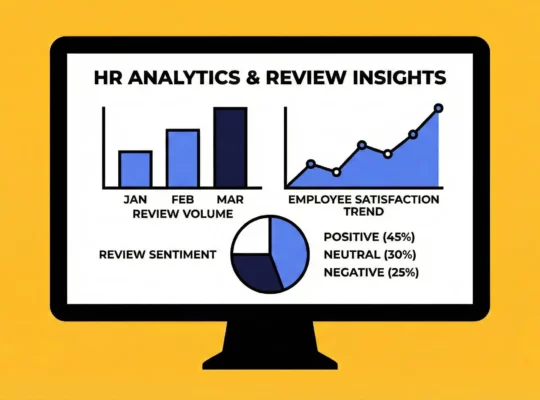Employee sentiment is more than just a feel-good metric — it’s the heartbeat of your organization. In today’s competitive business landscape, knowing how your employees feel about their work, leadership, and the company’s direction is crucial for sustainable growth. When employees feel heard and valued, they’re more engaged, productive, and loyal. When they’re not, performance suffers, morale plummets, and turnover rises. At Review.jobs, we help organizations tap into the power of employee feedback to build thriving, people-first cultures. In this comprehensive guide, we’ll explore what employee sentiment is, why it matters, how to measure it accurately, and how to transform insights into action that drives real change.
Table of Contents
1. What Is Employee Sentiment?
Employee sentiment refers to the collective emotional attitudes, feelings, and perceptions employees hold toward their workplace, leadership, job roles, colleagues, and organizational culture. It’s a snapshot of employee morale, engagement, and overall satisfaction.
Core Components of Employee Sentiment
Understanding employee sentiment requires more than a single survey question or engagement score. It’s a nuanced picture composed of several interrelated factors that influence how employees feel about their work, their teams, and the organization as a whole. Here are the core components that shape employee sentiment:
1. Job Satisfaction
Job satisfaction reflects how fulfilled employees feel in relation to their daily responsibilities, role clarity, and the overall structure of their work. Key drivers include clear expectations, a healthy balance of workload, autonomy in decision-making, and a sense of accomplishment from meaningful tasks. According to McKinsey, 70% of employees say their work significantly shapes their sense of purpose. When individuals find their work purposeful, well-organized, and appropriately challenging, it enhances overall sentiment and plays a critical role in reducing turnover.
2. Leadership Perception
Trust in leadership is a powerful driver of employee sentiment. This encompasses how employees view senior executives, direct managers, and organizational decision-making processes. Are leaders transparent? Do they communicate effectively and inspire confidence? Do employees feel their voices are heard at the top? A workforce that trusts its leadership is more likely to stay engaged, motivated, and aligned with company goals—even during periods of change or uncertainty.
3. Career Development
Career development opportunities—such as training, mentorship, upskilling programs, and internal promotions—play a crucial role in employee satisfaction. Workers are more likely to feel valued and stay loyal to a company that invests in their professional growth. A lack of growth pathways, on the other hand, can lead to stagnation, frustration, and disengagement. In modern workplaces, especially among Millennial and Gen Z employees, development isn’t a perk—it’s an expectation.
4. Workplace Culture
Culture is the emotional and social fabric of the organization. It includes the degree of inclusivity, psychological safety, collaboration, and how well employees align with company values. A strong, positive culture fosters a sense of belonging and purpose. When people feel safe to speak up, be themselves, and contribute meaningfully, overall sentiment thrives. Conversely, a toxic or exclusive environment can be a major drain on morale, even if other aspects of the job are satisfactory.
5. Work-Life Balance
Work-life balance measures how effectively employees can manage professional responsibilities alongside their personal lives. This includes flexible work policies, respect for personal time, reasonable expectations around overtime, and support for mental well-being. In today’s hybrid and remote work environment, work-life balance has become a key differentiator in employee satisfaction. Organizations that prioritize balance are more likely to retain talent, reduce burnout, and maintain high productivity.

2. Why Employee Sentiment Matters
Ignoring employee sentiment is like flying blind — you miss the subtle cues that indicate whether your people are thriving or merely surviving. Here’s why prioritizing sentiment is essential:
a. It Impacts Workplace Culture
Positive sentiment fosters trust, collaboration, and innovation. Employees who feel supported and empowered are more likely to contribute ideas, take initiative, and work cohesively across teams. On the flip side, unaddressed negative sentiment leads to cynicism, burnout, and a toxic work culture.
b. It Drives Productivity and Performance
When people are happy and engaged, their output improves. Teams with high morale report better collaboration, fewer mistakes, and stronger alignment with organizational goals. Sentiment is a leading indicator of productivity.
c. It Reduces Turnover and Absenteeism
Unhappy employees don’t stick around. Workplace happiness dropped sharply from 70% in 2023 to just 48% in 2024—a concerning decline that underscores the growing importance of actively monitoring and addressing employee sentiment. Poor sentiment leads to higher turnover rates, costing your business time, money, and continuity. Regular sentiment tracking allows you to spot disengagement early and take corrective action.
d. It Fuels a Strong Employer Brand
Your internal culture is your external brand. Companies with high employee sentiment attract top talent, receive better online reviews, and maintain a solid reputation in the job market. Candidates today don’t just apply — they research. Positive employee feedback can be your strongest recruiting tool.
3. How to Measure Employee Sentiment
To truly understand how your workforce feels, you need to go beyond gut instinct, hallway conversations, and anecdotal feedback. The most effective organizations rely on a multi-layered measurement strategy that blends both quantitative data (e.g., survey scores) and qualitative insights (e.g., open-text feedback) to paint a complete picture of employee sentiment.
a. Surveys and Questionnaires
Surveys remain one of the most powerful and scalable tools for measuring sentiment—when they’re designed and executed well. Below are the most common types and best practices for maximizing their impact:
Types of Surveys:
- Pulse Surveys
These are short, frequent check-ins (weekly, biweekly, or monthly) that track changes in employee sentiment over time. They’re especially useful after key organizational changes like leadership shifts, restructures, or major policy updates. Pulse surveys help identify trends and address issues before they escalate. - Annual Engagement Surveys
These comprehensive surveys offer a broad view of employee satisfaction, engagement, and alignment with organizational goals. Because of their depth, they’re ideal for long-term strategic planning and benchmarking against previous years. - Custom & Lifecycle Surveys
These surveys are tailored to specific employee experiences, such as:
- Onboarding feedback for new hires
- Exit surveys for departing employees
- Post-promotion or post-training evaluations
- Sentiment after leadership changes or organizational restructuring
These targeted surveys help HR leaders understand sentiment at crucial touchpoints throughout the employee journey.
- Onboarding feedback for new hires
Best Practices for Effective Surveys:
- Use a mix of question types: Combine quantitative (e.g., Likert scales) with qualitative (open-ended) questions to capture both measurable trends and the “why” behind them.
- Ensure anonymity: Anonymity boosts honesty. Employees are more likely to give candid feedback when they know their responses can’t be traced back to them.
- Keep surveys focused and brief: Respect employees’ time. Stick to specific themes or goals for each survey and avoid question overload.
- Act on the data: Employees want to know their voices matter. After collecting their anonymous reviews, communicate key findings and outline what actions will be taken. This closes the loop and builds trust in the feedback process.
Example Survey Questions to Gauge Sentiment:
- “On a scale of 1–10, how likely are you to recommend this company as a place to work?”
(Net Promoter Score-style question to track overall advocacy and engagement) - “What’s one thing we could do to improve your work experience?”
(Open-ended prompt for actionable insights) - “Do you feel valued and recognized for your contributions?”
(Measures employee appreciation and emotional connection) - “How confident are you in the direction our leadership is taking the company?”
(Assesses trust in leadership and strategic alignment) - “Do you have the tools and resources you need to do your job effectively?”
(Identifies gaps in support and infrastructure)
b. Employee Reviews and Anonymous Feedback
Anonymous feedback platforms like Review.jobs provide valuable, unfiltered insights into the employee experience. By enabling current and former employees to share structured, anonymous reviews, these tools help HR professionals uncover patterns and themes that may not surface in traditional surveys.
- Why It Works:
When anonymity is guaranteed, employees are more likely to be honest—especially about sensitive topics such as toxic leadership, discrimination, or poor management practices. - How to Use It Effectively:
- Monitor review trends over time to identify shifts in morale.
- Filter reviews by department, location, or role to uncover team-specific issues.
- Respond to patterns with transparent communication and clear action plans.
- Share positive reviews externally to support employer branding and recruitment.
- Monitor review trends over time to identify shifts in morale.
Reviews are not just a reputational tool—they’re a goldmine of raw sentiment that, when aggregated, can highlight blind spots in organizational culture or leadership.
c. Sentiment Analysis Tools
AI-powered sentiment analysis is rapidly transforming how HR teams interpret employee feedback. Instead of manually reading through hundreds (or thousands) of responses, sentiment analysis software uses Natural Language Processing (NLP) to automatically detect emotional tones and classify comments as positive, neutral, or negative.
Platforms like Review.jobs include built-in sentiment analysis features, allowing organizations to scale insights without sacrificing depth.
Key Benefits of Sentiment Analysis Tools:
- ✅ Speed & Scale: Analyze thousands of comments, emails, or survey responses in minutes.
- ✅ Theme Detection: Spot recurring issues like “lack of recognition,” “management trust,” or “poor communication.”
- ✅ Real-Time Dashboards: Visualize trends across teams and time periods for immediate, actionable insights.
- ✅ Uncover Hidden Trends: AI can detect emotional undercurrents that managers or HR leaders might miss in surface-level feedback.
Sentiment analysis software turns qualitative feedback into structured data—making it easier to tie employee sentiment to broader metrics like engagement, retention, and productivity.
d. Focus Groups and One-on-One Interviews
While surveys and digital tools offer a wide-angle view of sentiment, focus groups and interviews provide up-close and personal insight into employee emotions, beliefs, and experiences. These qualitative methods are essential for interpreting the “why” behind your data.
Types of Qualitative Feedback Sessions:
- Structured Interviews
Ask multiple employees the same set of questions for consistency and comparative analysis. Best for benchmarking sentiment across roles or departments. - Semi-Structured Interviews
Combine prepared questions with open dialogue, allowing you to explore unanticipated but meaningful topics that emerge naturally in conversation. - Focus Groups
These moderated group discussions help uncover collective themes, shared concerns, or cultural undercurrents. Focus groups work particularly well when exploring broad topics like leadership perception or organizational change.
Advantages of Qualitative Methods:
- Offer deep emotional context behind survey data
- Help HR uncover stories and examples that surface trends can’t capture
- Foster a sense of inclusion by making employees feel heard and valued
To get the most value, record these sessions (with consent), analyze transcripts for recurring themes, and use insights to shape follow-up questions for larger surveys or engagement campaigns.
4. Key Metrics and Qualitative Indicators
To make sentiment actionable, you need to track the right data. Here’s a breakdown of the most useful quantitative and qualitative indicators.
Quantitative Metrics
These metrics provide measurable data points:
- Employee Net Promoter Score (eNPS): Measures employee loyalty by asking how likely they are to recommend your company. A high eNPS suggests strong employee advocacy.
- Turnover and Retention Rates: High turnover often signals dissatisfaction. Retention improvements may reflect better sentiment.
- Absenteeism Rates: Frequent absences can indicate burnout, disengagement, or poor morale.
- Engagement Scores: Based on answers to standardized questions around motivation, commitment, and connection to work.
- Participation Rates: Low survey participation may signal apathy or distrust.
Qualitative Indicators
These offer context and emotional depth:
- Open-Ended Survey Responses: Analyzed for keywords and emotional tone to detect themes like frustration, gratitude, or confusion.
- Review Language Trends: Repeated mentions of specific leadership styles, company values, or pain points highlight systemic issues.
- Communication Reviews: Employees’ thoughts on transparency, clarity, and timeliness of internal communication often reflect deeper cultural sentiment.
By combining hard metrics with qualitative insights, organizations get a 360-degree view of employee sentiment.
5. Turning Sentiment Insights Into Action
Data without action is just noise. Once you’ve gathered sentiment insights, it’s time to close the feedback loop.
a. Identify Priorities
Use your sentiment data to pinpoint the top 2–3 areas of concern. This might be poor leadership communication, lack of recognition, or limited career growth.
b. Engage Stakeholders
Share insights with department heads and managers. Encourage collaborative brainstorming to address challenges revealed in the data.
c. Design Targeted Interventions
- If leadership scores are low: Invest in leadership training and improve transparency in decision-making.
- If workload stress is high: Reevaluate team structures, resource allocation, and deadlines.
- If development opportunities are lacking: Introduce mentorship programs or learning stipends.
d. Communicate Clearly
Let employees know what was learned and what’s being done about it. Transparency builds trust and shows that feedback matters.
e. Monitor Progress
Continue to measure sentiment over time. Benchmark improvements and adjust strategies as needed. Sentiment isn’t a one-time project — it’s an ongoing conversation.
6. Building a Competitive Employer Brand Through Sentiment Data
Organizations with a high-performing employer brand don’t just offer perks and pay — they offer purpose, recognition, and belonging. And that begins with listening to employee sentiment.
How Employee Sentiment Builds Employer Branding
- Better Online Reviews: Satisfied employees leave positive reviews on platforms like Glassdoor and Review.jobs.
- Word-of-Mouth Referrals: Happy employees refer talented peers, reducing hiring costs.
- Authentic Culture Marketing: Use employee reviews to shape career site messaging, social media content, and job descriptions.
- Reputation Management: Proactively addressing negative sentiment minimizes public backlash and reinforces your commitment to employee wellbeing.
Review.jobs: Your Sentiment Strategy Partner
With our NF-certified review collection tools, Review.jobs enables companies to gather, analyze, and publish authentic employee reviews — turning internal feedback into external credibility. Use our platform to:
- Track sentiment trends in real-time
- Benchmark against industry peers
- Publish verified reviews to boost employer visibility
- Identify early warning signs of disengagement
Final Thoughts
Employee sentiment is your strategic advantage. In today’s evolving workplace, understanding how your people feel is no longer optional — it’s essential for driving engagement, retention, innovation, and brand strength.
By measuring, analyzing, and acting on employee sentiment with the right tools and strategies, you can create a workplace where people love to contribute and grow.
Let Review.jobs help you build a feedback-rich culture and a standout employer brand. Start by listening. Act with purpose. And watch your organization thrive.
Ready to turn employee sentiment into business success?
👉 Schedule a demo with Review.jobs and discover how to unlock the full power of your workforce.
FAQs: Measuring Employee Sentiment
1. What is employee sentiment?
Employee sentiment refers to how employees feel about their work, leadership, workplace culture, and the overall organization. It captures emotional insights that influence engagement, performance, and retention.
2. Why is measuring employee sentiment important?
Understanding sentiment helps HR teams identify issues early, improve morale, and create a more positive work environment. It also supports better decision-making around culture, leadership, and communication.
3. What are the best tools to measure employee sentiment?
Surveys, anonymous review platforms like Review.jobs, AI-powered sentiment analysis tools, and interviews are all effective. A mix of these methods provides a more complete picture.
4. How often should we measure employee sentiment?
Use pulse surveys monthly or quarterly for ongoing feedback, and annual surveys for deep analysis. Regular check-ins help track trends and respond proactively.
5. How can we ensure honest employee reviews?
Maintain anonymity, communicate how reviews will be used, and act on the results. Trust is key to collecting authentic responses.





